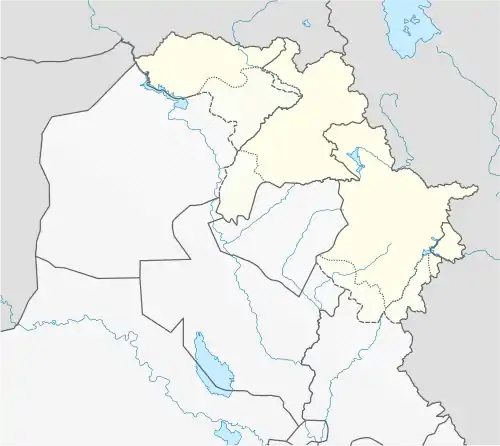Bassetki
Bassetki (Kurdish: باستکێ, romanized: Bassetkî)[1][2] is a small village in Iraq, in Dohuk Governorate of autonomous Kurdistan Region. The village is associated with several archaeological finds.
Bassetki
Arabic: باستكي | |
|---|---|
 Bassetki Location in Iraqi Kurdistan | |
| Coordinates: 36°57′31.6″N 42°43′17.4″E | |
| Country | |
| Governorate | Dohuk Governorate |
| Districts | Simele District |
History
The site was occupied in the Early Bronze, Middle Bronze, Mittani, Middle Assyrian, Neo-Assyrian, Hellenistic, Islamic, and Modern periods.
Archaeology
In 1975 a fragment of a figure of Naram-Sin of Akkad, known as Bassetki Statue, was discovered near Bassetki. The statue was stolen from the National Museum of Iraq during the Iraq War, but was later retrieved by US soldiers.[3]
Since 2016 archaeological excavations have been conducted in Bassetki by the Institute for Ancient Near Eastern Studies team from the University of Tübingen and Hasan Qasim from the Directorate of Antiquities in Dohuk.[4][5][3][6] They revealed a large Bronze Age city established in c. 3000 BC which flourished for more than 1,200 years.[3] From c. 2700 BC the city had a wall protecting the upper part of the city from invaders.[3] The city had an extensive road network, several residential districts and a palatial building. A contemporary cemetery was located outside the city. The city was connected to other regions of Mesopotamia and Anatolia by an overland roadway dating from c. 1800 BC. The archeologists also discovered settlement layers dating from the Akkadian Empire, which also encompassed the territory of modern Iraq. The finds were announced by the University of Tübingen on 3 November 2016.[7]
In the summer of 2017, archaeologists from the University of Tübingen in Germany uncovered, on the eastern slope (Area C), a collection of 3,200 year old cuneiform tablets hidden inside a collection of ceramic jugs. These tablets reveal the location of the ancient lost royal city of Mardaman that may have once stood where Bassetki lies today. The tablets date back to c. 1250 BC when the area was part of the Middle Assyrian Empire.[8] In the same room of the governor's building a number of Faience objects were found including bowls, ornaments, and tokens. Faience was apparently both produced and stored in the room.[9]
Excavation continued in 2018 and 2019.[10]
See also
References
- KRSO (2009). "2009 - ناوی پاریزگا. يه که کارگيرييه كانی پاریزگاكانی هه ریمی کوردستان" (PDF). Kurdistan Region Statistics Office (KRSO) (in Kurdish). p. 143. Archived from the original (PDF) on 2017-03-14. Retrieved 6 February 2021.
- "93 tabletên li ser dîroka Kurdan hatin dîtin". ANF News (in Kurdish). Retrieved 19 December 2019.
- "Significant Bronze Age city discovered in Northern Iraq". Science Daily. 4 November 2016. Retrieved 7 November 2016.
- Peter Pfälzner and Hasan A Qasim, The first and second seasons of the german-kurdish excavations at Bassetki in 2015 and 2016, Zeitschrift für Orient-Archäologie, vol. 10, pp. 10-43, 2017
- Peter Pfälzner et al., Urban developments in northeastern Mesopotamia from the ninevite V to the neo-assyrian periods: excavations at Bassetki, Zeitschrift für Orient-Archäologie, vol. 11, pp. 42-87, 2018
- "Archaeologists Unearth Bronze Age City in Iraq". Sci News. 6 November 2016. Retrieved 7 November 2016.
- "Bedeutende bronzezeitliche Stadt im Nordirak entdeckt" (in German). University of Tübingen. 3 November 2016. Retrieved 7 November 2016.
- "Cuneiform tablets from Bassetki reveal location of ancient royal city of Mardaman". University of Tübingen. 9 May 2018. Retrieved 15 May 2018.
- Puljiz, Ivana. "Faience for the empire: A Study of Standardized Production in the Middle Assyrian State" Zeitschrift für Assyriologie und Vorderasiatische Archäologie, vol. 111, no. 1, 2021, pp. 100-122
- Pfälzner, P./H. A. Qasim (2020): From Akkadian Maridaban to Middle-Assyrian Mardama. Excavations at Bassetki in 2018 and 2019, ZOrA 13, pp. 12-89
- Pfälzner P., Qasim H.A., Sconzo P. and Puljiz I., "Report on the first season of German-Kurdish excavations at Muqable in 2015", Zeitschrift für Orient-Archäologie 10, pp. 44-96, 2017
- Puljiz, I./H. A. Qasim (2018): Exploring the Middle Assyrian countryside in the Middle Tigris region. The 2017 season of excavations at Muqable III, ZOrA 11, 88–109
- Puljiz, I./H. A. Qasim (2020): The Middle Assyrian rural complex of Muqable, ZOrA 13, pp. 90-126
External links
- Video about the current excavations - Aug 18, 2020
- On the Fringe of Mesopotamia - Peter Pfalzner Oriental Institute lecture on the excavations at Bassketi
- Ancient Lost City of Mardaman Uncovered in Iraq - Live Science - 11 May 2018